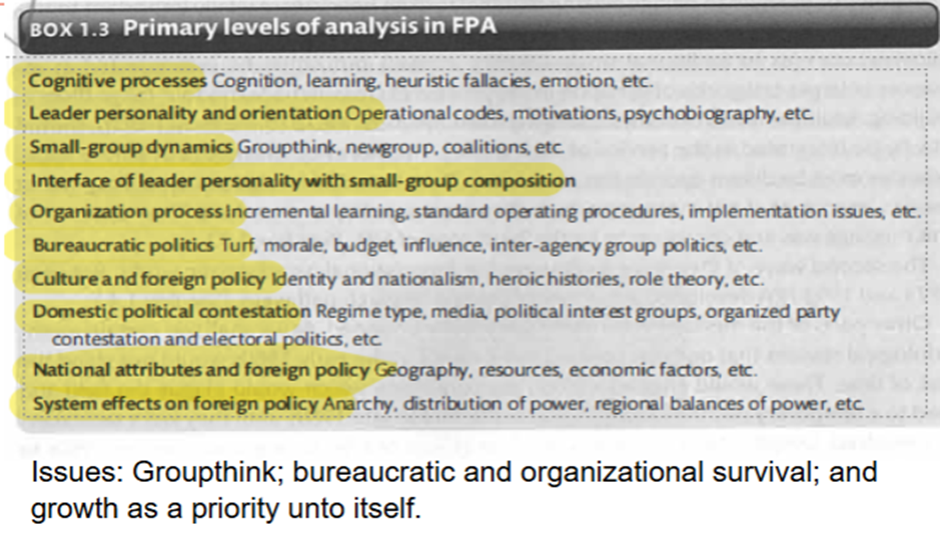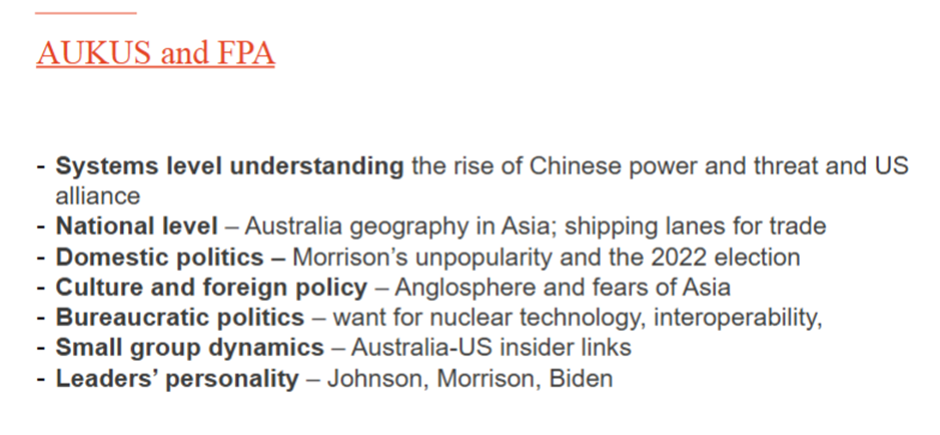Week eight: foreign policy analysis
1/22
There's no tags or description
Looks like no tags are added yet.
Name | Mastery | Learn | Test | Matching | Spaced |
|---|
No study sessions yet.
23 Terms
According to Waltz, what is the difference between foreign policy and international politics?
Foreign policy refers to the strategic choices and actions of individual states.
International politics refers to the systemic structure and the interaction of states within the international system.
Waltz argues it's crucial to separate unit-level analysis (foreign policy) from system-level analysis (international politics).
According to Waltz what is the system level focus of neorealism?
Waltz’s neorealism focuses on the structure of the international system, especially anarchy (absence of a global authority).
It treats states as like units (similar in function), differing only in capabilities.
Outcomes in international politics are often determined more by systemic pressures than individual state preferences or leaders.
According to Waltz, what is the fundamental flaw of foreign policy analysis?
Looking at individual leaders, cultures, or governments tells us about foreign policy decisions, but not about international politics as a whole.
For example, different foreign policies may result from similar systemic constraints.
What does Waltz criticise about Foreign policy?
Waltz criticizes approaches that conflate foreign policy and international politics because they lack theoretical clarity and predictive power.
A theory of international politics must be generalizable and parsimonious, not overly reliant on specific state behavior.
What is foreign policy?
The strategy of approach chosen by the national government to achieve its goals in its relations with external entities
What is foreign policy behaviour?
The observable artefacts of foreign policy - specific actions and words used to influence others in the realm of foreign policy, may include categorisation of behaviour. Could include behaviour accidental or unintentional. There is slippage between the concept of foreign policy and concept of foreign policy behaviour.
What is foreign policy analysis, and its hallmarks?
Seeks to explain foreign policy behaviour, with reference to the theoretical ground of human decision makers, acting singly and in groups. Its hallmarks include:
a commitment to look below the nation-state level of analysis to actor-specific information
committment to build actor specific theory as the interface between actor-general theory and complexity of the real world
commitment to pursue multicausal explanations spanning multiple levels of analysis
commitment to utilise theory and findings from across the spectrum of social sciences
commitment to viewing the process of foreign policy decision making as important as the output thereof.
What is actor general theory
theory that explains the behaviour of actors in general
What is actor specific theory?
theory that explains the behaviour of specific actors. It is a form of middle range theory → more generalisable than insights from case studies, but more severe scope conditions.
What does snyder say about FPA?
We adhere to the nation state as the fundamental unit of analysis, yet we have discarded the state as a metaphysical abstraction..emphasising decision making as a central focus.. organising the determinants of action…
What is the characteristic emphasis of foreign policy analysis?
Emphasis on foreign policy decision making (FPDM) as opposed to outcomes. Decision making was best determined by spheres of competence of the actors involved, communication and information flow, and motivations of the various players.
What is middle range theory?
Theory that mediated between grand principles and the complexity of reality.
What are the primary levels of analysis in Foreign Policy Analysis?
cognitive processes (emotions, cognition)
leader personality and orientation
small group dynamics
interface of leader personality with small group composition
bureacratic politics
culture and foreign policy (nationalism)
domestic and political contestation
national attributes and foreign policy
system effects on foreign policy (ie anarchy).
What is small group dynamics?
groupthink: how does a group come to understand → analogies of problem framing and how it complicates foreign policy. consider the Vietnam war.
What is organisational process and bureacratic politics?
Traes what instruments of statecraft (diplomatic, military, economics) were used in the influence attempt, or what level of commitment of resources was evident. Bheaviour as disparate as a war, treaty or state could now be compared and aggragated.
What is events data?
Andriole and Hopple (1981) estimate the US has provided over $5 million from the 60s to 80s to create coding for events.
What is foreign policy analysis in a nutshell?
-Subfield of international relations that seeks to explain foreign policy or foreign policy
behaviour
- Focuses on human decision makers, acting singly and in groups.
The subfield has several hallmarks:
- a commitment to look below the nation-state level of analysis to actor-specific
information;
- a commitment to build actor-specific theory as the interface between actor-general
theory and the complexity of the real world;
- a commitment to pursue multicausal explanations spanning multiple levels of analysis;
- a commitment to utilize theory and findings from across the spectrum of social science
- a focus on the particularities (biography; psychology and beliefs) of decision makers
- a focus not just on outcomes but also on the process and implementation of foreign
policy decision making (from Valarie Hudson, “Foreign Policy Analysis”)
What are the primary levels of analysis in foreign policy analysis?

What does Waltz say about international relations not being foreign policy?
Debunking the claim that FPA and IR theory are two separate forms of analysis
- Waltz wants to reduce IR theory into parsimonious theory. And then he wants to apply the formulas
- We can only say things that are descriptive and bring in multitudes of complexity. It’s what we call deductive reasoning and what we apply to the world. Start with the detail and then conduct a theory.
Kenneth Waltz “International Relations is not foreign policy” (1996)
- Waltz’s theory of IR “explains why states similarly placed behave similarly despite their internal differences. The explanation of states’ behavior is found at the international, and not at the national, level. That is why the theory is called a theory of international politics. In contrast, a theory of foreign policy would explain why states similarly placed in a system behave in different ways”
- “Our problem, recall, is that a neorealist theory of international politics explains how external forces shape states' behavior, but says nothing about the effects of internal forces.”
- “An international-political theory can explain states' behavior only when external pressures dominate the internal disposition of states, which seldom happens. When they do not, a theory of international politics needs help.”
What is a case study of analysis of FPA for AUKUS?

- f the world is moving against the five ‘I’ state, what do you do? You get the best technology you can afford
- Australian secretary of defence dept, the starting point for all analysis is the world map. Then you work out your priorities and ways of defending yourself nationally.
- American British build submarines and we need the submarines because of China.
- Culture – fears, geographically not in the region of white Anglo-saxon heritage
- Ideas of bureaucratic politics – if Australia has US military, we are a branch of them and thus more secure.
- Small group dynamics: promote these ideas when they have the opportunities
What is an FPA analysis of Russia and Ukraine?
- System level – NATO expansion and spheres of influence
- National level – Adjoining Borders, Russian Economic weakness, Russia decline
- Domestic level – Authoritarianism
- Cultural level – Russian imperialism, humiliation and militarism
- Leader and small group – Visions of power and grandeur
- Leader’s personality – Putin: invincible, hero, saviour, winner
- Cognitive processes – Speculation about Putin’s cognitive decline and aging
FPA: Foreign policy analysis; multicausal, it’s the sense of national vulnerability and adjoining borders, sense of internal Russian decline, pride, cultural identity requires a Russian nationalist leader. So they bring other multilevel in.
What is feminist foreign policy analysis?
Sweden’s “three Rs”:
- women’s and girl’s Rights;
- women’s Representation in decisionmaking processes;
- and the necessary Resources to promote gender equality and equal opportunities.
(Zimmerman 2020, p.1)
- Generally is a focus on women’s support in disaster settings, resourcing existing organisations and about ensuring that training is offered at a capacity to organise women in formal political organisations. Ensuring that investment is being given to build capacity in other countries. Argued as the first wave of feminist foreign policy.
- Its criticisms are that it doesn’t consider gender as a relation of power, and it overemphasises women at the expense of gender equality more broadly and intersectionality and resource allocation.
- Adds women rather than dismantling.
What do Lyric and Thomson say about feminist foreign policy?
“Feminist Foreign Policy is the policy of a state that defines its interactions with
other states and movements in a manner that prioritizes gender equality and
enshrines the human rights of women and other traditionally
marginalized groups, allocates significant resources to achieve that vision
and seeks through its implementation to disrupt patriarchal and male-
dominated power structures across all of its levers of influence (aid, trade,
defense and diplomacy), informed by the voices of feminist activists,
groups and movements” (Lyric and Thompson 2019, p.7)